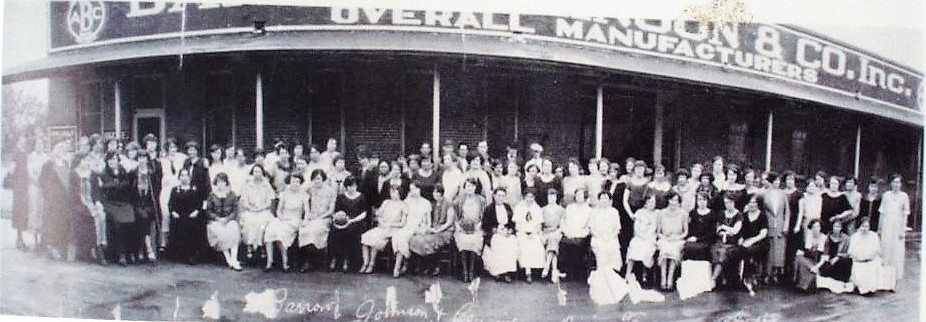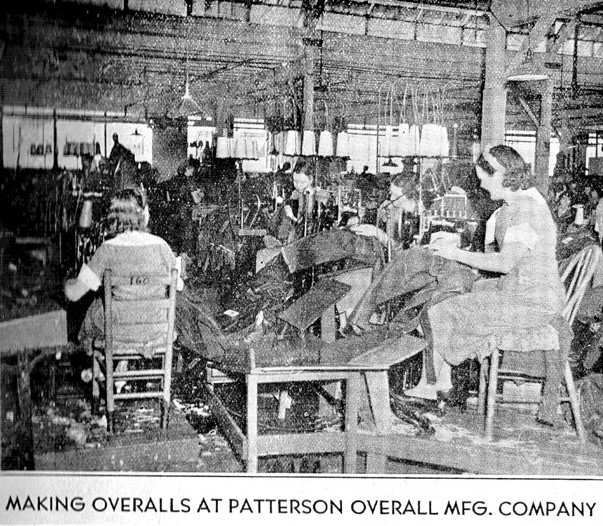Levi Strauss Company
Denison plant
Denison, Texas
When
Houston Ave. was the buzzing and exciting place to be, a large home was
built in 1873 at the southeast corner of Gandy St. and Houston Ave.;
Michael and Maggie Hanna operated the place as the Hanna House for many
years.
William R. White, who came to Denison from Bonham before
1900, set up his produce company at 607 W. Main St. but soon moved into
the building at 100 West Chestnut. Deciding he needed an even
larger facility for his growing produce company, he struck a deal to
buy the Hanna House. This he tore down and erected the White Produce Co.; he continued to operate his produce business for 19 years when he ceased operations and left the city.
J.B.
Johnson then bought the acreage and opened his Barrow/Johnson Overall
Manufacturers in 1925, operating his company until 1929 when he also
left Denison.
The building was then purchased by Cowden Manufactures
and later in 1933 Patterson Overall Manufacturers moved in, both of
which manufactured overalls. Patterson Overall Manufacturers
occupied the structure from 1933 until 1939 when it was relocated to
Miami, Oklahoma.

216 N. Houston Ave.

Southern
Ice Co., operated by William Ryles, putchased the structure in 1939, as
well as other buildings on the block. The building remained empty
for more than a decade except when Kraft used it as a warehouse and the
Roller Bowl used a portion of it for a short time. In 1949 the Levi Strauss Co. moved in, staying for 17 years.
Denison Press
March 11, 1949
FROM BOLT OF DENIM TO LEVI'S IN ONLY 25 MAN HOURS
By Mary Lou Cox
From
a bolt of denim to 50 pairs of Levi's in 25 man hours of labor in the
seemingly incredible record of the Levi Strauss Company factory workers
who are engaged in turning out these famous blue denim work pants at
the newly opened Denison factory.
Supervised by Mrs. Heinzel,
forelady of the San Francisco plant, who was borrowed for a while until
other supervisors could be trained from the present working personnel,
the 70 people now employed in the sewing room are zipping through 47
separate operations that go into the making of each garment with
fabulous speed.
An entire bolt of material, all 855 yards, is
spread out the entire length of the 120-foot cutting table, 108
thickness deep; the cutting foreman, Vey Nicholas, armed with an
electric cutter soon has the yardage transformed into 50 potential
pairs of Levi's. The pieces are then taken up stairs to the
sewing room where each operator has an individual job to perform.
The pants are passed from one machine to another until they reach
the last operator who applies the distinguishing copper rivets to each
pair by hand.
ORIGIN OF THE COPPER RIVETS
Started as a joke,
the use of copper rivets on the Levi's developed into one of the most
important features of the garment. A tailor by the name of John
Davis had a small shop in Virginia City, in the gold mine territory and
in addition to making clothes for the dandies of the area did a lot of
repair work on the clothing of the miners. One of these was a
character known as Alkall Ike, who was forever coming in to have the
corners of his pockets sewed up. Owing to the collection of
various things a miner was in the habit of carrying in his pockets, the
seams were always ripping. Davis, the tailor, finally got tired
of Alkall's complaints and one day took his pants to a harness maker
where he proceeded to reinforce his repair job on the pockets with
black-iron square nails.
Alkall,
after several trips to the various bars, was in a condition to notice
the innovation, and the joke went the rounds of Virginia City after he
left for his mine. But on his return the joke was turned, for he
was delighted that his pockets were as good as new. From this
idea, with the help of Mr. Strauss, to whom he recounted the incident,
came the use of riveted pockets on work clothes and a patent for tailor
Davis.
At the time the copper riveted garments were made Levi
Strauss decided upon the use of the copper colored thread, and these
distinguishing marks of Levi's continue today.
DURABLE MATERIAL
A
special extra heavy denim is used for Levi's, developed over a number
of years by the mills to comply with Mr. Strauss' repeated demands for
a material that would stand up under the hard wear to which the work
pants would be subjected. The Cole Mills Corporation of
Greensboro, North Carolina, furnish all the denim used by the company,
and Levi Strauss and company buy the entire output of mills of that
particular quality of material. They buy in carload lots, Mr.
Young said. The material is shipped in bales and unloaded at the
back door of the local plant. Though the material is all
identical in weight, it may vary slightly in shade so far that reason,
all parts of each garment come from the same bolt of cloth.
Each
garment is inspected when finished, and in the event of one mistake it
is ripped up and resewed and subjected to a second inspection.
The
finished products are shipped to various retailers in the Southwest.
All sales are to independent merchants, nothing is sold in
wholesale lots, Mr. Young said.
Local merchants who will handle Levis are the J.W. Madden company, Dad and Lads, and The Leader.
"If
progress in the Denison plant is as we expect it to be, Mr. Young said,
"It is quite possible that the company will seek additional facilities
before long.


DENISON HISTORY
Copyright © 2024, TXGenWeb.
If
you find any of Grayson County TXGenWeb
links inoperable,
please
send me a message.



